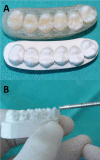Micro-CT evaluation of microleakage under orthodontic ceramic brackets bonded with different bonding techniques and adhesives
- PMID: 25855655
- PMCID: PMC4914757
- DOI: 10.1093/ejo/cjv023
Micro-CT evaluation of microleakage under orthodontic ceramic brackets bonded with different bonding techniques and adhesives
Abstract
Aim: The aim of this study was to evaluate microleakage under orthodontic ceramic brackets bonded with direct and different indirect bonding techniques and adhesives using micro-computed tomography.
Materials and methods: A total of 30 human maxillary premolars were randomly separated into five groups with six teeth in each group. In group I, teeth were bonded directly with Transbond XT (3M Unitek). In group II, group III, group IV, and group V, teeth were bonded through an indirect technique with Custom I.Q. (Reliance Orthodontic Products), Sondhi Rapid-Set (3M Unitek), RMbond (RMO), and Transbond IDB (3M Unitek), respectively, following the manufacturer's instructions. Micro-CT system model 1172 of Skyscan (Kontich, Belgium) was used to scan all samples. NRecon (Skyscan) version 1.6, CT-Analyser V.1.11 (Skyscan), and TView (SkyScan, Bvba) software programs were used for microleakage evaluation. Microleakage values between the test groups were assessed using the Kruskal-Wallis test, while the Wilcoxon signed rank test was used for within-group comparisons. The level of significance was set at P < 0.05.
Results: According to the Kruskal-Wallis analysis of variance test, there were no significant differences among the tested groups, with regard to volume and percentage (microleakage/region of interest × 100) of microleakage values (P < 0.05). The Wilcoxon signed rank test showed that coronal microleakage volume and percentage values significantly differed for RMbond and Transbond IDB groups.
Limitations: In the study, only ceramic brackets were used and microleakage into mini gaps did not show up on the micro-CT image because 50% silver nitrate solution could not penetrate into mini gaps which are smaller than silver nitrate particles.
Conclusion: Use of direct and indirect bonding techniques with different adhesives did not significantly affect the amount of microleakage.
© The Author 2015. Published by Oxford University Press on behalf of the European Orthodontic Society. All rights reserved. For permissions, please email: journals.permissions@oup.com.
Figures



Similar articles
-
Microleakage under orthodontic brackets bonded with the custom base indirect bonding technique.Eur J Orthod. 2010 Jun;32(3):259-63. doi: 10.1093/ejo/cjp090. Epub 2009 Sep 13. Eur J Orthod. 2010. PMID: 19752016 Clinical Trial.
-
Microcomputed tomography assessment of microleakage and void formation under ceramic adhesive precoated orthodontic brackets.Am J Orthod Dentofacial Orthop. 2025 Feb;167(2):221-231. doi: 10.1016/j.ajodo.2024.09.013. Epub 2024 Nov 22. Am J Orthod Dentofacial Orthop. 2025. PMID: 39580722
-
Microleakage under metallic and ceramic brackets bonded with orthodontic self-etching primer systems.Angle Orthod. 2008 Nov;78(6):1089-94. doi: 10.2319/100507-481.1. Angle Orthod. 2008. PMID: 18947278
-
Microleakage beneath brackets bonded with flowable materials: effect of thermocycling.Eur J Orthod. 2009 Aug;31(4):390-6. doi: 10.1093/ejo/cjn126. Epub 2009 Mar 31. Eur J Orthod. 2009. PMID: 19336628
-
Microleakage.J Dent. 1992 Feb;20(1):3-10. doi: 10.1016/0300-5712(92)90002-t. J Dent. 1992. PMID: 1548383 Review.
Cited by
-
Effects of different removal methods of excess resin adhesive on the microleakage of alumina all-ceramic crowns.BMC Oral Health. 2023 Nov 11;23(1):854. doi: 10.1186/s12903-023-03581-z. BMC Oral Health. 2023. PMID: 37951856 Free PMC article.
-
Shear bond strength of a flash-free orthodontic adhesive system after thermal aging procedure.J Clin Exp Dent. 2019 Feb 1;11(2):e154-e161. doi: 10.4317/jced.55540. eCollection 2019 Feb. J Clin Exp Dent. 2019. PMID: 30805120 Free PMC article.
-
Relevance of Micro-leakage to Orthodontic Bonding - a Review.J Dent Biomater. 2016 Sep;3(3):254-260. J Dent Biomater. 2016. PMID: 28959751 Free PMC article. Review.
-
Evaluation of Microleakage in Flash-Free and Conventional Ceramic Brackets: A Microcomputed Tomography Study.Turk J Orthod. 2024 Dec 31;37(4):242-248. doi: 10.4274/TurkJOrthod.2024.2024.21. Turk J Orthod. 2024. PMID: 39743863 Free PMC article.
-
Effectiveness, efficiency and adverse effects of using direct or indirect bonding technique in orthodontic patients: a systematic review and meta-analysis.BMC Oral Health. 2019 Jul 8;19(1):137. doi: 10.1186/s12903-019-0831-4. BMC Oral Health. 2019. PMID: 31286897 Free PMC article.
References
-
- Silverman E., Cohen M. (1974) Current adhesives for indirect bracket bonding. American Journal of Orthodontics, 65, 76–84.
-
- Aguirre M.J., King G.J., Waldron J.M. (1982) Assessment of bracket placement and bond strength when comparing direct bonding to indirect bonding techniques. American Journal of Orthodontics, 82, 269–276. - PubMed
-
- Milne J.W., Andreassen G.F., Jakobsen J.R. (1989) Bond strength comparison: a simplified indirect technique versus direct placement of brackets. American Journal of Orthodontics and Dentofacial Orthopedics, 96, 8–15. - PubMed
-
- Sondhi A. (1999) Efficient and effective indirect bonding. American Journal of Orthodontics and Dentofacial Orthopedics, 115, 352–359. - PubMed
-
- Zachrisson B.U., Brobakken B.O. (1978) Clinical comparison of direct versus indirect bonding with different bracket types and adhesives. American Journal of Orthodontics, 74, 62–78. - PubMed
Publication types
MeSH terms
Substances
LinkOut - more resources
Full Text Sources
Other Literature Sources

